If you’ve been following my series on Planting to Attract Birds, you may already have a few plants in mind to attract hummingbirds to your garden. Who wouldn’t want to bring that energy and life into their garden?
Even though I’m a landscaper and get to see hummingbirds every day, they never lose their magic for me. I love to see them guarding “their” sage or Buddleia and tweeting irritably at me to get lost already (sorry guys! The weeds don’t stop for anyone!), nesting safely in shrubs and small trees, and zooming about in search of their next meal.
While planting is the best way to attract them, both for providing food and shelter, during the lean winter months a feeder can be a very kind gift. Feeders take more work than most plants, but your hummingbirds will be very grateful to have a nectar backup in case the neighborhood shrubs fail them.
Using a hummingbird feeder
No need to buy fancy food packets for your feeder; instead, make a simple sugar solution by boiling 4 parts water, removing the water from the stove, and stirring in 1 part sugar until dissolved. You can keep your prepared sugar water in the fridge for one-two weeks.
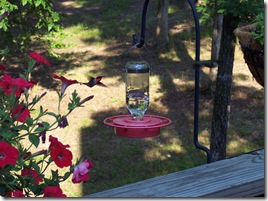 Making your own solution works well because flower nectar is sucrose, just like in regular white sugar, so you’re giving them the same kind of sugar as they’d get in nature. Don’t add red coloring – most feeders have a red accent to attract hummers, and food coloring isn’t healthy for them. Stick with white sugar; honey and other alternative sugars are more prone to ferment and go bad.
Making your own solution works well because flower nectar is sucrose, just like in regular white sugar, so you’re giving them the same kind of sugar as they’d get in nature. Don’t add red coloring – most feeders have a red accent to attract hummers, and food coloring isn’t healthy for them. Stick with white sugar; honey and other alternative sugars are more prone to ferment and go bad.
Place your feeder out of direct sun, and once a week, rinse out your feeder with hot water and let it dry before refilling with sugar solution. If your sugar water goes cloudy or you see mold inside the feeder, clean the feeder with a 10% bleach solution to kill off any fungus.
Hummingbirds will appreciate having a perch near the feeder where they can rest in between drinks, so if possible, put your feeder near a small tree or openly branched shrub where they can sit safely. If you have a territorial hummingbird, they’ll appreciate having a safe place to sit and guard the feeder from others.
Now, on to some favorite hummingbird plants!
Ceanothus ‘Dark Star’ or Dark Star California Lilac
Ceanothus are California natives that do admirably in the garden, as long as you don’t overwater them (reduce the summer water after the 2nd year).
‘Dark Star’ has a stiff, upwardly arching habit to 6’, tiny leaves, and such a neat and defined look that it works well in Japanese gardens. They make little blue poofs in spring – mine are blooming right now in early March – and the hummingbirds love their nectar!
Ever hear the phrase “live fast, die young”? That’s exactly what Ceanothus do. They get to mature size in 3-5 years, then slowly edge towards an early death at age 15 or so. That’s a short life for a shrub, but for most people the fact that it reaches maturity so fast makes it worthwhile.
‘Dark Star’ is seriously low-maintenance, too. The only pruning you ought to do on it is to remove the dead branches that pile up underneath the good foliage in time. If you need to prune a tiny bit to adjust the form when they’re young, go ahead, but pruning ‘Dark Star’ is like 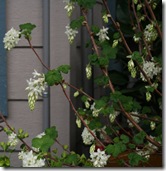 pruning a pine – if you remove a branch, nothing’s growing back to replace it, so choose your cuts carefully.
pruning a pine – if you remove a branch, nothing’s growing back to replace it, so choose your cuts carefully.
The evergreen foliage and arching habit of ‘Dark Star’ look great with our native White Flowering Currant, Ribes sanguineum ‘Alba’, which is also a hummingbird magnet.
Grevillea lanigera ‘Coastal Gem’
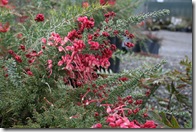 ‘Coastal Gem’ is an evergreen groundcover with the dual attributes of being hard to kill and extremely floriferous (sorry for the geeky word, I can’t help myself sometimes!). It’s a surprisingly rare combination.
‘Coastal Gem’ is an evergreen groundcover with the dual attributes of being hard to kill and extremely floriferous (sorry for the geeky word, I can’t help myself sometimes!). It’s a surprisingly rare combination.
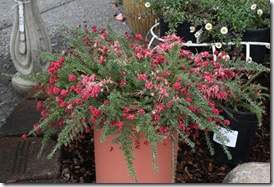 They arch outward and tumble casually over hillsides and garden beds, getting to about 2’ tall by 5’ wide in time, and they bloom off and on all year in my coastal climate, even in winter. The hummingbirds love the masses of reddish-coral and cream flowers that cover the plant, and so do kids! The flowers look like weird alien insects and they’re kinda fun to flick at people (not that I’d know personally, I am far too mature for such things!).
They arch outward and tumble casually over hillsides and garden beds, getting to about 2’ tall by 5’ wide in time, and they bloom off and on all year in my coastal climate, even in winter. The hummingbirds love the masses of reddish-coral and cream flowers that cover the plant, and so do kids! The flowers look like weird alien insects and they’re kinda fun to flick at people (not that I’d know personally, I am far too mature for such things!).
I love to place them near deep purple Heucheras/ Coral Bells, like ‘Obsidian’, which show off so nicely against the velvety grey foliage.
Only things I’ve ever seen kill them are overhead water from a lawn sprinkler, and poor-draining, heavy clay soil. They’ll take little summer water once established, and only need pruning if you’ve planted them too close to their neighbors.
Check out Iona’s close-up photography of this lovely plant over at Iona’s Fort Bragg Garden. Iona’s a retired librarian, and she’s unearthed some great info about this Grevillea.
If you need a taller shrub, Grevillea rosmarinifolia ‘Scarlet Sprite’ is a cheerful 5/6-footer. It has greener, lighter foliage than ‘Coastal Gem’, and the flowers are a bit brighter red as well.
![]() ‘Scarlet Sprite’ is another sturdy shrub which looks best when left unpruned. The leaves are a bit spiky, so I’d give it the space to spread out where you aren’t going to be squeezing past all the time. Surprisingly, it looks great with the slightly different foliage and flowers of ‘Coastal Gem’, and I’ve had two clients decide they liked them right up next to each other! Hummingbird heaven…
‘Scarlet Sprite’ is another sturdy shrub which looks best when left unpruned. The leaves are a bit spiky, so I’d give it the space to spread out where you aren’t going to be squeezing past all the time. Surprisingly, it looks great with the slightly different foliage and flowers of ‘Coastal Gem’, and I’ve had two clients decide they liked them right up next to each other! Hummingbird heaven…
Salvia leucantha and other Sages
Salvia leucantha or Mexican Bush Sage is one of my favorite plants ever. The fuzzy purple spikes rise above the grayish-green foliage, getting longer and longer through the year until winter, when the fuzz drops off along with the leaves.
The fuzzy spikes are actually calyces, and the flowers are smaller white or purple tubes that accent the main show. The regular Salvia leucantha has purple spikes with little white flowers (my favorite!), while ‘Santa Barbara’ and ‘Midnight’ have (respectively) lighter and deeper shades of purple flowers that blend with the fuzzy bits.
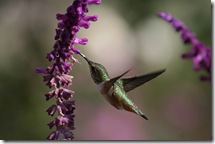 They are tender, and so each year I leave the old stems on the plant to help protect any new growth from frost until I think it’s safe out, and only then do I prune out all of last year’s stems. The new foliage is so pretty as it emerges, and usually when the plant is about a foot tall, flower spikes begin unfurling, starting the show. They’ll get to about 4’ tall and 5’+ around, and if you plant them in landscape fabric be sure and leave a 3’ hole so they can spread out a bit.
They are tender, and so each year I leave the old stems on the plant to help protect any new growth from frost until I think it’s safe out, and only then do I prune out all of last year’s stems. The new foliage is so pretty as it emerges, and usually when the plant is about a foot tall, flower spikes begin unfurling, starting the show. They’ll get to about 4’ tall and 5’+ around, and if you plant them in landscape fabric be sure and leave a 3’ hole so they can spread out a bit.
Once established, these guys are tough as nails and can tolerate little summer water. They do best with good drainage and will flower for you from May through first frost, when they die back completely to the ground.
A quick rundown of some other favorites:
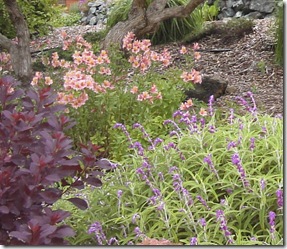 Florist’s Alstroemeria or Peruvian Lily is an amazing garden plant – easy to grow, blooms early, fun to care for and full of color!
Florist’s Alstroemeria or Peruvian Lily is an amazing garden plant – easy to grow, blooms early, fun to care for and full of color!
There are versions that are a foot tall (the Princess line) and 4’ sprawlers like ‘Regina’, pictured. Read more about how to choose and care for Alstroemerias here.
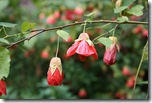 Abutilon hybrids or Flowering Maples are wonderful in the ground or in pots. They vary greatly in size (3-15’!) and color (shades of white, pink, red, yellow, and orange), so it’s easy to find one that’s right for your spot.
Abutilon hybrids or Flowering Maples are wonderful in the ground or in pots. They vary greatly in size (3-15’!) and color (shades of white, pink, red, yellow, and orange), so it’s easy to find one that’s right for your spot.
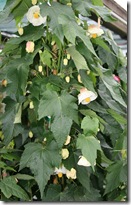 The bell-shaped flowers are full of nectar, and one year we had a hummingbird fall so in love with our Abutilon (A. megapotomicon ‘Red’) that she nested in the trellis I used to espalier it.
The bell-shaped flowers are full of nectar, and one year we had a hummingbird fall so in love with our Abutilon (A. megapotomicon ‘Red’) that she nested in the trellis I used to espalier it.
Monterey Bay Nursery has some of the best information on the different varieties available, as well as photos of each.
 Nepeta faassenii or Catmint is one of those airy, prettily-textured plants that everyone seems to love. It goes with bright colors every bit as well as it supports more restrained plantings with grasses and foliage colors.
Nepeta faassenii or Catmint is one of those airy, prettily-textured plants that everyone seems to love. It goes with bright colors every bit as well as it supports more restrained plantings with grasses and foliage colors.
‘Walker’s Low’ gets to about 1’ tall and 3’ wide when in bloom, while ‘Six Hills Giant’ gets about 3’ tall and 4’ wide. They both get cut back to nubs in winter.
I hope this gives you some fun inspiration in getting started attracting hummingbirds to your garden! They are such lovely creatures to watch, and nothing perks up a gloomy day like seeing the red shimmer of their feathers and hearing them zipping past.
Stay tuned for the last installment of my bird-attracting series, in which I’ll talk about container plants that birds love.
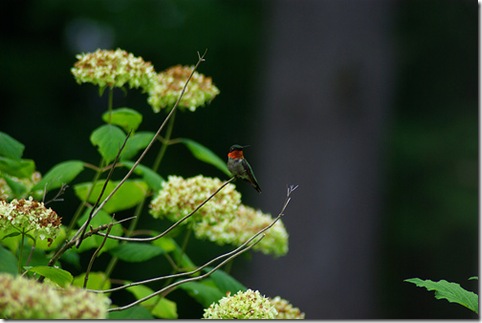
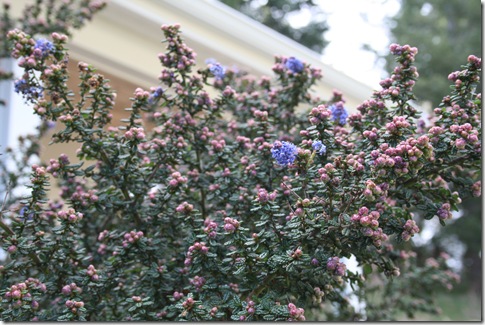
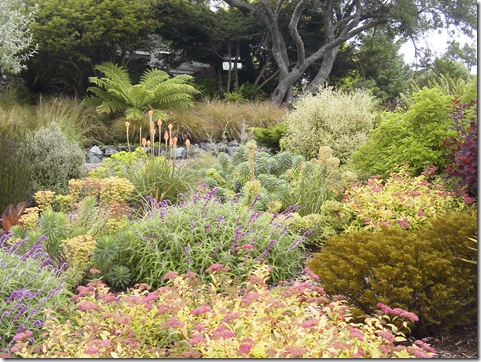
15 responses to “Nectar Plants for the Hummingbirds to Enjoy”
Hi Gen
I’m so glad that I unknowingly planted so many shrubs for the hummers. Love the coastal gem and the ribes and the CA lilac but I don’t think the Fort Bragg rats, oh I mean deer are aware that the Ceanothus is supposed to be deer resistant. They were chowing down regularly until the rains started. We planted them to create a hedge to screen off the leeeeeechhhh field (yuck). Didn’t work. They’re about the same size as they were when we planted them a year ago. Chomp, chomp. Liquid Fence sort of worked but not well enough to allow them to mature to 6′. We’re seriously considering fencing our property with a gate but at 10K+ we’re still thinking.
Man Gen, I know you’re a landscaper and garden coach, but the amount of info about plants that you know is amazing!
Hummingbirds are my absolute favorite reason to garden. I feel genuine sorrow for the world outside of the Americas because they don’t have hummingbirds. Heck, I actually go to sleep at night thinking of new plants and strategies to attract more hummingbirds to my patio, and also to the garden outside my window at work.
I second your note about washing the feeder out on a weekly basis. The other day I noticed that there was black mold growing inside my feeder. Yuck!!! I’m sure the hummers didn’t think too highly of my moldy nectar either. It was a total pain to wash out too, because of the narrow opening of my feeder.
Fern’s last blog post..Houston, We have Lift Off….Er, I Mean Germination!
Exquisite! One of the biggest gripes I have against Nature is that we dont have hummingbirds in India : (
The closest we get to them are our tiny sunbirds. Close, but not the real thing.
Sunita’s last blog post..Crafting : Oh my gourd-ness !
Genevieve,
Salvia leucantha tops my list too! Fell in love with it two Januarys ago when I was out in Fremont, CA and saw it blooming alongside the southeast corner of Diablo Canyon Road and Mission Blvd. You drooled over my beef pot pies with puff pastry. Well I drooled over that huge shrub of Mexican Bush Sage! Couldn’t believe my eyes. Blooming in early January. Just not fair for us New England gardeners. It’s very hard to find this out our way to grow as an annual. Maybe once every 4-5 years I come across a nursery that sells it if I’m lucky.
Enjoyed reading about your suggestions here, a number of them new ones for me. Our lilacs bring the hummingbirds into the yard in June. Then they wrestle each other over the monardas in July. And finally the pineapple sage I struggle to winter over under lights each year comes through in late August and September as a last hurrah for them. These keep them more happy than the feeder I hang out so I think I’ll forgo the feeder this year and let the plants do the work for me ;>)
Ann’s last blog post..Winter Staples
Hi Genevieve, how amazing to have hummingbirds there all year. The plants you show are all beautiful, but only a couple will winter over here, the catnip being a big favorite. What do you think about the ants getting into the feeders? Ignore them, or get one of the guards offered in the catalogs?
Frances
Frances’s last blog post..Faces Redux
Wow, Iona – the same variety, Dark Star, is getting chowed down on? That’s a serious bummer. You might try fencing them off (just a small fence of deer-netting and stakes in the ground) the first few years until they get some size behind them – but – maybe it’s not worth it, if you have other successful shrubs that they aren’t eating.
I’m so with you, Fern – hummingbirds are so magical for me. They are a good portion of the reason I became a landscaper – when thinking about what I wanted to do with my life – landscaping, journalism/ writing, or a number of other things – I met a hummingbird up-close and wonderful and he hung out with me for twenty minutes acting curious. It made me realize I could be outdoors having experiences like that every day, and I never looked back from my career choice.
Sunita, your sunbirds are lovely, but I’d be mourning my lack of hummers too! You do get some awe-inspiring butterflies, though! I’ve never seen anything like your blue one.
Ann, I pulled a bit of a fake-out with that big salvia – it’s still dormant now, actually – those are early June photos! How funny that it’s hard to find there as an annual! I divide a few giant plants of it every year and end up taking truckloads of starts to the green waste dump! I only wish it would ship well to you.
Hi Frances! I’d get one of those ant guards, personally. From what I’ve read, hummingbirds really don’t like icky/ fermented sugar solution, and I bet ants introduce all kinds of fungus and bacteria into your feeder, since they walk everywhere.
Being a coastal gardener definitely has its perks! I was happy to see that catmint under a layer of snow on Monica the Garden Faerie’s blog recently, on the post about gardening with kitties. Nice to know how sturdy it is!
Love the photos! How did you get it to sit still? Great plants, too! I tend to just stick with the plants. Seems like the hummers always find something. And with those plants you show, who needs a feeder?
Renate’s last blog post..The Great Front Garden Remodel: Before
I also like hummingbird and cardinal creeper vines (annuals) for hummingbirds, plus a few other annuals that my brain is not cooperating in remembering.
Monica’s last blog post..GBBD – At last!
Nice run down!
Along with some other goodies, I planted 5 flowering currant bushes and 3 trees on Friday. I thought I was buying two plants, heh. I need to be better about reading the stickers (or at least counting how many sticks are poking out of the top of the bag!). Last month, I got 15 raspberry bushes instead of 3, lol. Anyway, let the hummingbirds come. 🙂
Lindsay’s last blog post..How to Drive Traffic to Your Site by Posting in Forums
Hummingbirds are the best little friends you can have in your garden, they are amusing and they pollinate. I plant bee balm ,canna lillies and larkspur for them. To help me they will get nectar from my tomato flowers. Thank you for the info on ants in the feeder. I will be more vigilant.
[…] very sturdy Fuchsia attracts hummingbirds to its plentiful tiny […]
[…] I hope this gives you some inspiration for your own bird garden. Stay tuned for the next installment – the best nectar plants for hummingbirds! […]
Humming birds are amazing creatures. I planted a pair of chitalpa (misspelled?) trees that give beautiful flowers. Little did I know they attract hummingbirds. While inspecting the trees I have had the pleasure of having a couple hummingbirds buzz right over the top of me. Never had seen some that close. Very cool birds! Thanks for the tips on adding more hummingbird attractors to my garden!
Am anticipating establishing a hummingbird garden in Portland,Oregon, area and woiuld
apprciate any hints. One year I had quite a flock of hummers covering a Japanese quiince
shrub. It is nice to read of so many people who are also enthusiastic about hummers.
[…] do you attract hummingbirds? Lots and lots of nectar plants. Your local natives will have flowers that are well-suited to the beak size and seasonal needs of […]